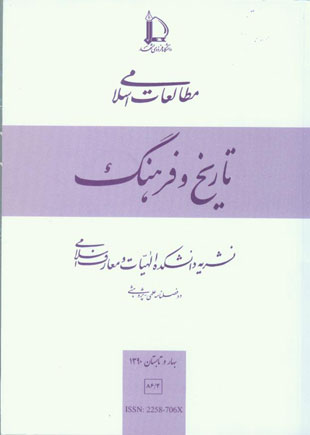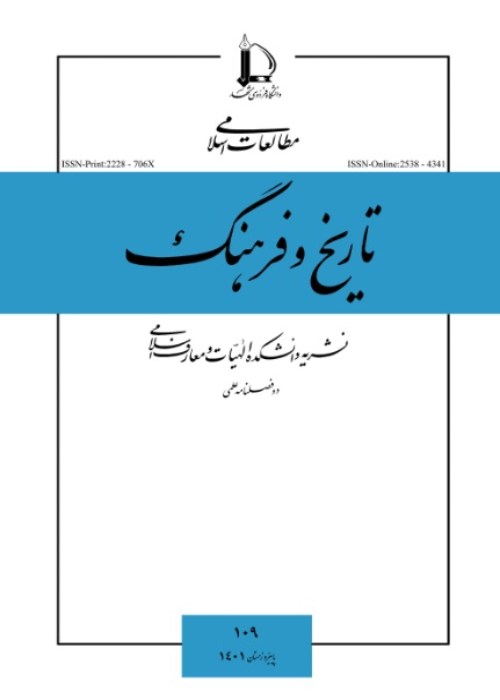فهرست مطالب

نشریه تاریخ و فرهنگ
سال چهل و سوم شماره 1 (پیاپی 86، بهار و تابستان 1390)
- 150 صفحه، بهای روی جلد: 8,000ريال
- تاریخ انتشار: 1391/03/25
- تعداد عناوین: 6
-
-
صفحه 9بحران مشروعیت دینی صفویان در اواخر عمر این سلسله موجب قیام ها و شورش های متفاوتی در نواحی مختلف قلمرو آنها شد. یکی از مهمترین این قیام ها را شیخ بهاءالدین استیری در خراسان رهبری کرد. شیخ که از بی توجهی دولت و دربار صفوی نسبت به حملات ازبکان به خراسان به ستوه آمده بود، راهی اصفهان شد. هشدارهای دلسوزانه او در اصفهان نادیده گرفته شد و خود نیز به تصوف و کفر متهم گردید. او پس از بازگشت به خراسان و با گردآوری یارانی، دست به اقدامی جهادی زد اما به زودی و با اعزام سپاه صفوی، حرکت او در هم کوبیده شد.
یافته های تحقیق نشان می دهد این قیام در سال های پایان عمر سیاسی دولت صفوی تحت تاثیر بحران های ناشی از ضعف مشروعیت دینی صفویان صورت پذیرفته است. همچنین سرکوب این قیام، انگیزه خیرخواهی برای حفظ این دولت را از بین برد. این ماجرا و نمونه های مشابه، زمینه را برای سقوط صفویه فراهم نمود.
کلیدواژگان: شیخ بهاءالدین استیری، مشروعیت صفویان، خراسان، شاه سلطان حسین -
صفحه 29تاریخ نگاری محلی ایران که سابقه آن به پیش از اسلام می رسد، در عصر قاجار با یک دوره طلایی رشد کمی و کیفی مواجه گردید. بیشتر شهرها و مناطق کشورمان صاحب یک یا چند تاریخ محلی گردیدند. در این مقاله پس از بررسی در حدود پنجاه اثر چاپ شده تاریخ محلی عصر قاجار، به بررسی ویژگی ها و علل این نهضت و مولفه های این نوع تاریخ نگاری می پردازیم. نیز بدین امر نظر داریم که انگیزه مولفان در آفرینش کتاب هایشان چه بوده است.
کلیدواژگان: تاریخ نگاری محلی، عصر قاجار، اعتمادالسلطنه، مانکجی لیموچی -
صفحه 53فتوت یکی از عوامل اثرگذار در حیات معنوی، سیاسی و اجتماعی فرهنگ و تمدن ایران و جهان اسلام بوده است. توجه به ریشه ها و خاستگاه های این پدیده مهم در تمدن اسلامی ما را در شناخت بهتر آن یاری می رساند. بی گمان در شکل گیری، تطور و گسترش فتوت عوامل عدیده ای از جمله برخی تعالیم اسلام و اوضاع تاریخی و اجتماعی و معنوی خاص اثرگذار بوده اند، اما وجود شباهت ها میان این پدیده با عناصر، مذاهب و مراسم و باورهای برجا مانده از اعصار کهن ایران، پژوهنده را به ناگزیر متقاعد می سازد که شاید بتواند ریشه های آن را در پیشینه این مرز و بوم بجوید. بی گمان فتوت به سان هر پدیده اجتماعی دیگری احتمالا ریشه های دیگری هم داشته باشد که می توان در مقالی دیگر به آنها هم پرداخت؛ اما در نوشتار کنونی ما با ارائه پنج دلیل اصلی معتقدیم که این ریشه ها را می توان در مظاهر گوناگون تمدن ایران پیش از اسلام جست.
کلیدواژگان: فتوت، فتیان، عیاران، قلندران، اسباران، ادیان ایران باستان، ادیان رازباور -
صفحه 83پدیده گروش به اسلام در سرزمین های فتح شده به دست عربان مسلمان از جمله موضوعات مبهم و مناقشه برانگیز در مطالعات تاریخ اسلام است. بخش عمده ای از دگرگونی اجتماعی قبطیان در مصر اسلامی به تغییر دین آنان از مسیحیت به اسلام باز می گردد. تبدیل تدریجی این گروه از اکثریت به اقلیتی تحت حاکمیت مسلمانان فرآیند پیچیده ای بود، زیرا مسلمانان نه با اخراج قبطیان بلکه با تغییر دین آنان در این سرزمین تبدیل به اکثریت شدند. روزگار خلافت الحاکم بامرالله فاطمی، شاهد تغییر آیین شمار بسیاری از مسیحیان قبطی به اسلام بود. گروش قبطیان در این دوره ریشه در فشارها و محدودیت های سیاسی، اجتماعی و مذهبی داشت که از سوی خلیفه بر جامعه قبطی تحمیل شد. با وجود این فرآیند اسلام پذیری اینان کامل نشد، چرا که پس از رفع اجبار از نوکیشان بسیاری از آنان از مسلمانی انصراف دادند و به مسیحیت بازگشتند.
کلیدواژگان: گروش به اسلام، اسلام پذیری قبطیان، ارتداد قبطیان، الحاکم فاطمی -
صفحه 95کتاب روضه الشهداء تالیف ملاحسین واعظ کاشفی (د. 910 ق) یکی از تاثیرگذارترین آثار سده های اخیر پیرامون واقعه کربلاست که به سبب اشاعه اخبار مجعول در تالیفات تاریخی و باور عمومی مورد انتقاد قرار گرفته است و آن را از اسباب اصلی رواج اخبار کذب و ضعیف تاریخی درباره واقعه کربلا دانسته اند. مسئله پژوهش حاضر این است که آیا تمام دروغ ها و تحریف های مربوط به واقعه کربلا از این کتاب نشات گرفته است یا پیش از این کتاب نیز وجود داشته است؟ در صورت منفی بودن پاسخ، دلایل ورود چنین اخباری به کتاب چه بوده است؟ یافته های این پژوهش نشان می دهد که روضه الشهداء سرچشمه همه اخبار مجعول مربوط به واقعه کربلا نیست و بسیاری از این دست اطلاعات ماخوذ از منابع پیش از کاشفی است. مقاله حاضر به بررسی اخبار ضعیف تاریخی و چگونگی ورود آنها در روضه الشهداء و نیز علل چند سده رواج این کتاب در جوامع سنی و شیعی اختصاص دارد.
کلیدواژگان: روضه الشهداء، ملاحسین واعظ کاشفی، روایات عامیانه واقعه کربلا، عزاداران امام حسین (ع)، گسترش تشیع -
صفحه 121در عصر پهلوی اول با روی کار آمدن رضاشاه، مدرنیزاسیون در کلیه ارکان و ابعاد دولت در دستور کار قرار گرفت و سعی بر آن شد تا نظام قضایی نیز از دایره شمول مدرنیزاسیون برکنار نماند. رویکرد دولت پهلوی در مدرنیزاسیون نظام قضایی دوری جستن از نظام قضایی شرعی و تمایل به ساختارهای عرفی بود که با واکنش هایی از سوی علما مواجه گردید، چرا که در حوزه نظام قضایی علمای شیعی به طور سنتی همواره خود را متولی امر قضا می دانستند. دولت پهلوی اول، در راستای تشکیل نظام قضایی نوین مبتنی بر ساختارهای عرفی، آن دسته از علمای شیعی را که با این ساختارها مخالف بودند، از دستگاه قضایی کنار گذاشت، ولی تعدادی از علمای شیعی به رغم مخالفت های کلی با سبک و سیاق تحول نظام قضایی دوره پهلوی اول، در دستگاه عدلیه باقی مانده و موثر واقع شدند و با مشارکت در تهیه و تدوین مجموعه قوانین مورد نیاز عدلیه، قانون مدنی و سایر قوانین موزد نیاز بر طبق فقه اسلامی، نقش قضایی خود را به اثبات رسانیدند.
کلیدواژگان: نظام قضایی، علمای شیعی، علی اکبر داور، رضا شاه پهلوی
-
Page 9The crisis of the religios legitimacy of Safavids close to the end of this dynasty’s governance triggered many uprisings and rebellions in different parts of their ruling domain. Sheikh Baha_al_Din Estiri was the leader of one of the most important uprisings in Khorasan. The sheikh, who has been frustrated with the Safavid court and government’s indifference regarding the Ozbacks’ attacks made on Khorasan, set up to Isfahan. His conscientious warnings were ignored in Isfahan and he was accused of sufism and unbelief. After returning to Khorasan and gathering his followers together, he took a stuggling measure that did not last long and the Safavid army crushed this movement. With due respect to the importance of the issue especially the evaluation of the social and religious status of Iran during Shah Sultan Hossein Safavi’s ruling, the objective here is to analyze Sheikh Baha_al_Din Estiiri’s insurrection. The main assumption of this study is that the “Estiri’s uprising testifies the religious and ethical weaknesses of SafavidLegitimacy”. The suppression of this famous rebellion annihilated the will of the protection of Safavid state among people. The suppression of this noble attempt and similar acts paved the way for Safavid collapse.Keywords: Sheikh Baha, al, Din Estiri, Legitimacy, Safavids, Khorasan, Shah Sultan Hossein
-
Page 29Local historiography in Iran, precedence of which can be traced back to the Iranian pre-Islamic era, saw a golden age of quantitative and qualitative growth under the Qajar dynasty.Hence,most of our country's cities and rigions possessed at least one local history.After examining some fifty printed works on local histories of the Qajarid period, it has been studied in the article the characteristics and causes of this literary movement and the components of this kind of historiography.A survey of the historygrapher's motives receives attention in this article too.Keywords: Qajarid Period, Local Historiography, Etemad al saltaneh, Manikji Limoji
-
Page 53Futuwwha was one the influential factors in the moral, political and social life of Iranian and Islamic civilization and culture.The examination of the origins and roots of this important phenomenon helps us to know it better.There have been doubtlessly several factors,such as certain teachings of Islam and some of the historical, social and moral circumstances, in its development,but considering the similarities between the phenomenon and the sectarian,ritual and ideological survivals from the ancient ages of Iran, it can be convincing that we may trace its roots to the land's ancient background.Futuwwah as any other social phenomenon may have had other origins as well, but in this article, presenting five major reasons, we discuss that its origins can be found in the different manifestations of pre-Islamic Iranian civilization.Keywords: Futuwwah, Fityan, Ayars, Qalandars, Asbars, Pre, Islamic Iranian Religions, Mystery Religions
-
Page 83The phenomenon of Conversion to Islam in the territories conquered by the Muslim Arabs, is one of the ambiguous and controversial topics in the Studies of Islamic History. Major part of the social transformation of Copts in Islamic Egypt returns to their Conversion from Christianity to Islam. Gradual changing of the majority to a minority group under Muslim rule was a complex process, because Muslims not with Expulsion of the Copts but with their Conversion to Islam were to become the majority in this country. The Fatimid al-Hakim era, saw the Conversion of a large number of Coptic Christians to Islam. Coptic Conversion, in this period, in the political, social and religious pressures and constraints, were imposed by the caliph on the Coptic community. However, the process was not complete because, after the forced Conversion was removed many of the converts returned to their past religion,ie ChristianityKeywords: Conversion to Islam, Conversion of Copts to Islam, Copts, Apostasy, Fatimid Al Hakim
-
Page 95Rawzah al- Shuhada, by Mulla Husayn Wa‘iz-i- kashifi (d. 910 A.H), is one of the most influential books on Karbala tragedy in recent centuries. Nevertheless, it has been criticized by the shi‘a scholars for spreading Spurious narratives among later works and public beliefes as well. The present article, discussing uncreditable narratives and falsifications in the work of Kashifi, intendes to investigate causes of its wide influence. The findings of the present study show that not all the unfounded narratives on the Karbala tragedies originated from Rawzah al- Shuhada since many of them are found in the earlier sources. Moreover, it was not the intention of Kashifi to write a history but to provide a simple comprehensive believabale report on the Karbala. These advantages, bringing acceptability for the work of Kashifi, made it the best available source for Shi‘a preachers and narrators of the tragedies of Karbala.Keywords: Rawzah al Shuhada, Mulla Husayn Waiz kashifi, shia vulgar narratives on Karbala, spread of Shiism
-
Page 121During the Pahlavid first period,ie after Reza Shah's ascencion to the throne,the modernization of all the pillars of state,including the juridical system was brought to government's attention.The government's approach in this process was keeping itself away from the religious legal system and inclining to secular structures.This approach aroused ulama's reaction,because they considered themselves custodians of jurisprudence.As a result,the government removed these scholars who opposed to the modern structures from juridical office.However, a few of them, despite their general disapproaval of the current juridical development, remained in the Department of Justice and continued to be effective.They contributed to the production and compilation of the legal code, required by the Department of Justice,and necessary civil laws according to the Islamic jurisprudence.Keywords: Juridical System, Shiite Scholars(ulama), Ali Akbar Davar, Reza Shah, Modernization


